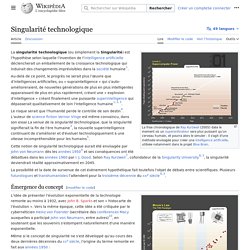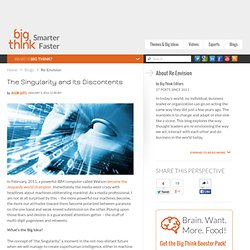

Eliezer Yudkowsky: Scruter la Singularité (Hache/essais) La version courte : Si les vitesses de calcul doublent tous les deux ans, qu’arrive-t-il quand des IA informatisées font la recherche ?

La vitesse de calcul double tous les deux ans. La vitesse de calcul double tous les deux ans de travail. La vitesse de calcul double tous les deux ans subjectifs de travail. Deux ans après que les Intelligences artificielles ont atteint l’équivalence humaine, leur vitesse double. Six mois ; trois mois ; 1,5 mois… Singularité. Prenez les valeurs correspondant aux vitesses de calcul actuelles, à leur temps de doublement actuel, et à une estimation de la puissance de calcul brute du cerveau humain, et les valeurs coïncident en : 2021. Mais personnellement, j’aimerais le faire plus tôt. 1.
L’Histoire a commencé il y a trois milliards et demi d’années dans une flaque de boue, quand une molécule a fait une copie d’elle-même et est ainsi devenue l’ancêtre ultime de toute vie terrestre. Il y a cinquante mille ans avec l’émergence d’Homo sapiens sapiens. 2. 2.1. Singularité technologique. Au-delà de ce point, le progrès ne serait plus l’œuvre que d’intelligences artificielles, ou « supraintelligence » qui s’auto-amélioreraient, de nouvelles générations de plus en plus intelligentes apparaissant de plus en plus rapidement, créant une « explosion d'intelligence » créant finalement une puissante superintelligence qui dépasserait qualitativement de loin l'intelligence humaine[1],[2],[3].

Le risque serait que l'humanité perde le contrôle de son destin[4]. L'auteur de science fiction Vernor Vinge est même convaincu, dans son essai La venue de la singularité technologique, que la singularité signifierait la fin de l'ère humaine[3], la nouvelle superintelligence continuant de s'améliorer et d'évoluer technologiquement à une vitesse incompréhensible pour les humains[5]. Cette notion de singularité technologique aurait été envisagée par John von Neumann dès les années 1950[6] et ses conséquences ont été débattues dans les années 1960 par I.
J. Good. Lawrence Krauss et Glenn D. Wired 8.04: Why the future doesn't need us. Why the future doesn't need us.

Our most powerful 21st-century technologies - robotics, genetic engineering, and nanotech - are threatening to make humans an endangered species. By Bill Joy From the moment I became involved in the creation of new technologies, their ethical dimensions have concerned me, but it was only in the autumn of 1998 that I became anxiously aware of how great are the dangers facing us in the 21st century. I can date the onset of my unease to the day I met Ray Kurzweil, the deservedly famous inventor of the first reading machine for the blind and many other amazing things. Ray and I were both speakers at George Gilder's Telecosm conference, and I encountered him by chance in the bar of the hotel after both our sessions were over. While I had heard such talk before, I had always felt sentient robots were in the realm of science fiction. It's easy to get jaded about such breakthroughs. I found myself most troubled by a passage detailing adystopian scenario:
The Singularity Is Not Near. What's the Latest Development?

Professor of neuroscience at Johns Hopkins University, David Linden doesn't believe man will be fused with machine any time soon. At least not in the way that futurist Ray Kurzweil envisions the (near) future. One of Kurzweil's predictions is that by the 2020s, minuscule nano-robots will enter our brains, non-invasively through our capillaries, and be able to manipulate our sensory receptors to create the first true virtual reality. Linden responds: "Even if our intrepid nanobot were jet-powered and equipped with a powerful cutting laser, how would it move through the brain and not leave a trail of destruction in its wake? " What's the Big Idea? Kurzweil predicts that by the 2030s, we will be able to upload our minds into a highly sophisticated computer, at which point the distinctions between brain, mind and machine would fall away.
The Singularity and Its Discontents. In February, 2011, a powerful IBM computer called Watson became the Jeopardy world champion.

Immediately, the media went crazy with headlines about machines obliterating mankind. As a media professional, I am not at all surprised by this – the more powerful our machines become, the more our attitudes toward them become polarized between paranoia on the one hand and weak-kneed submission on the other. Playing upon those fears and desires is a guaranteed attention-getter – the stuff of multi-digit pageviews and retweets. What's the Big Idea? The concept of “the Singularity,” a moment in the not-too-distant future when we will manage to create superhuman intelligence, either in machine form or by augmenting our own brains with biotechnology, is particularly effective at inspiring this kind of technophobia or technophilic zealotry. The movement has its fervent detractors. Paul Root Wolpe: Physics also thought it was going to find its grand unified theory a long time ago.